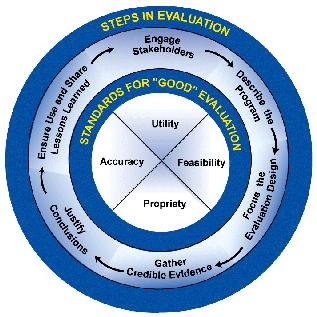Tool 1: Tools Related to the Recommended Framework
See the following Community Tool Box sections for additional information.

Engage Stakeholders
To help you understand who stakeholders are:
Understanding Community Leadership, Evaluators, and Funders: What Are Their Interests?
Identifying Targets and Agents of Change: Who Can Benefit and Who Can Help
Identifying Community Assets and Resources
To learn how to involve stakeholders:
Involving Key Influentials in the Initiative
Involving People Most Affected by the Problem
To work together with a diverse group:
Training for Conflict Resolution
Encouraging Involvement of Potential Opponents as well as Allies
Describe the Program
To fully understand the need, problem, or goal that the program addresses:
Defining and Analyzing the Problem
Conducting Needs Assessment Surveys
Conducting Public Forums and Listening Sessions
To better explain the activities, components, and elements of the program:
Designing Community Interventions
Identifying Strategies and Tactics for Reducing Risks
To be able to describe resources and assets for the program:
Identifying Community Assets and Resources
For examples of logic models:
Our Model of Practice: Building Capacity for Community and System Change
Our Evaluation Model: Evaluating Comprehensive Community Initiatives
To look broadly at your program and its context:
An Overview of Strategic Planning or "VMOSA" (Vision, Mission, Objectives, Strategies, Action Plan)
Understanding and Describing the Community
To modify the program to fit the local context:
Adapting Community Interventions for Different Cultures and Communities
To learn to explain the program to others (and so that they see your point of view):
Focus the Evaluation Design
To clarify the purpose:
To identify potential users and uses:
Understanding Community Leadership, Evaluators, and Funders: What Are Their Interests?
To clarify evaluation questions:
For illustrative evaluation questions:
Our Model of Practice: Building Capacity for Community and System Change
For help identifying specific evaluation methods:
Some Methods for Evaluating Comprehensive Community Initiatives
Developing Baseline Measures of Behavior
Obtaining Feedback from Constituents: What Changes are Important and Feasible?
For guidance about making agreements:
Identifying Action Steps in Bringing About Community and System Change
Gather Credible Evidence
For support in implementing specific evaluation methods:
Some Methods for Evaluating Comprehensive Community Initiatives
Developing Baseline Measures of Behavior
Obtaining Feedback from Constituents: What Changes are Important and Feasible?
Justify Conclusions
To see an illustrative process for considering evidence:
Our Model of Practice: Building Capacity for Community and System Change
Ensure use and share lessons learned
To promote the use of what your organization has learned:
Providing Feedback to Improve the Initiative
Conducting a Social Marketing Campaign
Attracting Support for Specific Programs
To share what you have learned with diverse groups:
Making Community Presentations
Communications to Promote Interest
Tool 2: Evaluation Standards
Use this table to determine how well your evaluation met "good" standards for evaluation.
| Standard | Did the evaluation meet this standard? (Yes or No) | Comments: |
| Utility Standards | ||
| 1. Stakeholder Identification | ||
| 2. Evaluator Credibility | ||
| 3. Information Scope and Selection | ||
| 4. Values Identification | ||
| 5. Report Clarity | ||
| 6. Report Timeliness and Dissemination | ||
| 7. Evaluation Impact | ||
| Feasibility Standards | ||
| 1. Practical Procedures | ||
| 2. Political Viability | ||
| 3. Cost Effectiveness | ||
| Propriety Standards | ||
| 1. Service Orientation | ||
| 2. Formal Agreements | ||
| 3. Rights of Human Subjects | ||
| 4. Human Interactions | ||
| 5. Complete and Fair Assessment | ||
| 6. Disclosure of Findings | ||
| 7. Conflict of Interest | ||
| 8. Fiscal Responsibility | ||
| Accuracy Standards | ||
| 1. Program Documentation | ||
| 2. Context Analysis | ||
| 3. Described Purposes and Procedures | ||
| 4. Defensible Information Sources | ||
| 5. Valid Information | ||
| 6. Reliable Information | ||
| 7. Systematic Information | ||
| 8. Analysis of Quantitative Information | ||
| 9. Analysis of Qualitative Information | ||
| 10. Justified Conclusions | ||
| 11. Impartial Reporting | ||
| 12. Metaevaluation |
Tool 3: Steps in Evaluation Practice and the Most Relevant Standards
Codes following each standard designate the conceptual group and number of the standard. U = Utility; F = Feasibility; P = Propriety; A = Accuracy.
| Steps | Most Relevant Standards |
| Engage Stakeholders | Metaevaluation (A12) Stakeholder identification (U1) Evaluator Credibility (U2) Formal agreements (P2) Rights of human subjects (P3) Human Interactions (P4) Conflict of interest (P7) |
| Describe the program | Complete and fair assessment (P5) Program documentation (A1) Context analysis (A2) |
| Focus the evaluation design | Evaluation impact (U7) Practical procedures (F1) Political viability (F2) Cost effectiveness (F3) Service orientation (P1) Complete and fair assessment (P5) Fiscal responsibility (P8) Described purposes and procedures (A3) |
| Gather credible evidence | Information scope and selection (U3) Defensible information sources (A4) Valid information (A5) Reliable information (A6) Systematic information (A7) |
| Justify conclusions | Values identification (U4) Analysis of quantitative information (A8) Analysis of qualitative information (A9) Justified conclusions (A10) |
| Ensure use and share lessons learned | Evaluator credibility (U2) Report clarity (U5) Report timeliness and dissemination (U6) Evaluation impact (U7) Disclosure of findings (P6) Impartial reporting (A11) |



